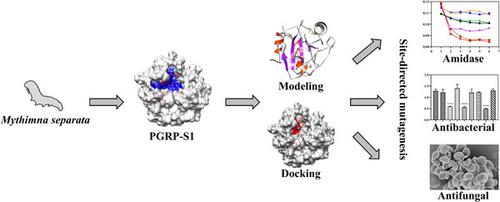当前位置:
X-MOL 学术
›
Arch. Insect Biochem. Physiol.
›
论文详情
Our official English website, www.x-mol.net, welcomes your
feedback! (Note: you will need to create a separate account there.)
Structure–function analysis of PGRP‐S1 from the oriental armyworm, Mythimna separata
Archives of Insect Biochemistry and Physiology ( IF 1.5 ) Pub Date : 2021-01-11 , DOI: 10.1002/arch.21763 Fang‐Fang Liu 1 , Hao Li 1 , Pei‐Jin Yang 1 , Xiang‐Jun Rao 1
Archives of Insect Biochemistry and Physiology ( IF 1.5 ) Pub Date : 2021-01-11 , DOI: 10.1002/arch.21763 Fang‐Fang Liu 1 , Hao Li 1 , Pei‐Jin Yang 1 , Xiang‐Jun Rao 1
Affiliation

|
Peptidoglycan recognition proteins (PGRPs) are well known for their abilities to recognize or hydrolyze peptidoglycan (PGN), one of the major bacterial cell wall components. However, much less is known about their antifungal activities. PGRP‐S1 was previously identified from a crop pest, Mythimna separata (Walker) (Lepidoptera: Noctuidae). PGRP‐S1 showed bacteriolytic activities against Gram‐positive and Gram‐negative bacteria. In this study, tissue expression analysis showed that PGRP‐S1 was mainly expressed in the midgut of naïve larvae. The induction analysis showed that it was significantly induced in the larval midgut 12 h post the injection of Beauveria bassiana conidia. To identify the key residues that are related to its microbicidal activities, the structure of PGPR‐S1 was predicted for structural comparison and molecular docking analysis. Six residues (H61, H62, Y97, H171, T175, and C179) were mutated to Ala individually by site‐directed mutagenesis. The recombinant wild‐type (WT) and mutant proteins were expressed and purified. The recombinant proteins bound to different polysaccharides, PGNs, and bacteria. H61A, Y97A, H171A, and C179A lost amidase activity. Accordingly, antibacterial assay and scanning electron microscopy confirmed that only H62A and T175A retained bacteriolytic activities. The germination of B. bassiana conidia was significantly inhibited by WT, H61A, Y97A, T175A, and C179A mutants. Electron microscopy showed that some conidia became ruptured after treatment. The growth of hyphae was inhibited by the WT, H61A, H62A, and T175A. In summary, our data showed that different residues of PGRP‐S1 are involved in the antibacterial and antifungal activities.
中文翻译:

东方粘虫Mythimna separata PGRP-S1的结构-功能分析
肽聚糖识别蛋白(PGRP)以其识别或水解主要细菌细胞壁成分之一的肽聚糖(PGN)的能力而闻名。但是,人们对其抗真菌活性的了解还很少。PGRP-S1先前是从一种农作物害虫Mythimna separata(Walker)(鳞翅目:夜蛾科)中鉴定出来的。PGRP-S1对革兰氏阳性和革兰氏阴性细菌显示出细菌分解活性。在这项研究中,组织表达分析表明PGRP-S1主要在幼稚幼虫的中肠表达。诱导分析表明,球孢白僵菌注射后12 h,其在幼虫中肠被明显诱导。分生孢子。为了鉴定与其杀微生物活性相关的关键残基,预测了PGPR-S1的结构,以进行结构比较和分子对接分析。通过定点诱变,六个残基(H61,H62,Y97,H171,T175和C179)分别突变为Ala。表达并纯化了重组野生型(WT)和突变蛋白。重组蛋白与不同的多糖,PGN和细菌结合。H61A,Y97A,H171A和C179A失去了酰胺酶活性。因此,抗菌测定和扫描电子显微镜证实只有H62A和T175A保留了细菌分解活性。球芽孢杆菌的萌发分生孢子被WT,H61A,Y97A,T175A和C179A突变体显着抑制。电子显微镜显示治疗后一些分生孢子破裂。菌丝的生长被WT,H61A,H62A和T175A抑制。总之,我们的数据表明,PGRP-S1的不同残基参与了抗菌和抗真菌活性。
更新日期:2021-02-09
中文翻译:

东方粘虫Mythimna separata PGRP-S1的结构-功能分析
肽聚糖识别蛋白(PGRP)以其识别或水解主要细菌细胞壁成分之一的肽聚糖(PGN)的能力而闻名。但是,人们对其抗真菌活性的了解还很少。PGRP-S1先前是从一种农作物害虫Mythimna separata(Walker)(鳞翅目:夜蛾科)中鉴定出来的。PGRP-S1对革兰氏阳性和革兰氏阴性细菌显示出细菌分解活性。在这项研究中,组织表达分析表明PGRP-S1主要在幼稚幼虫的中肠表达。诱导分析表明,球孢白僵菌注射后12 h,其在幼虫中肠被明显诱导。分生孢子。为了鉴定与其杀微生物活性相关的关键残基,预测了PGPR-S1的结构,以进行结构比较和分子对接分析。通过定点诱变,六个残基(H61,H62,Y97,H171,T175和C179)分别突变为Ala。表达并纯化了重组野生型(WT)和突变蛋白。重组蛋白与不同的多糖,PGN和细菌结合。H61A,Y97A,H171A和C179A失去了酰胺酶活性。因此,抗菌测定和扫描电子显微镜证实只有H62A和T175A保留了细菌分解活性。球芽孢杆菌的萌发分生孢子被WT,H61A,Y97A,T175A和C179A突变体显着抑制。电子显微镜显示治疗后一些分生孢子破裂。菌丝的生长被WT,H61A,H62A和T175A抑制。总之,我们的数据表明,PGRP-S1的不同残基参与了抗菌和抗真菌活性。











































 京公网安备 11010802027423号
京公网安备 11010802027423号